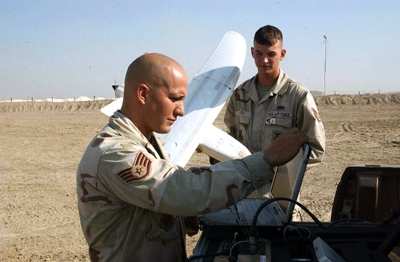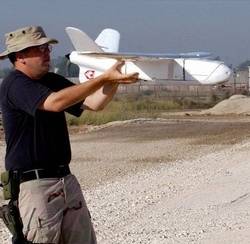Not Every Unmanned Aerial Vehicle In The Sky Here Is A
Predator
The 332nd Expeditionary Security Forces Squadron is using its
"Desert Hawk" UAV in Iraq, providing an extra set of eyes in the
sky for looking for potential terrorists and criminals.
"Desert Hawk allows us to interdict our adversaries before they
are able to threaten (airmen) and resources," said Maj. Glen
Christensen, 332nd ESFS commander. "With this equipment, we can
achieve the desired … base defense."

The Desert Hawk UAV system’s official name is the Force
Protection Airborne Surveillance System, a small, 7-pound remote
control led aircraft used by security forces airmen. The
battery-powered aircraft has a wingspan of about 4 feet and flies
for about an hour using its on-board rechargeable batteries.
For all the fancy adjectives and acronyms, the Desert Hawk is a
remarkably simple, yet durable aircraft.
"The manual describes the plane as a state-of-the-art composite
material, but it’s actually got a lot more in common with a
Styrofoam cup than anything else," said Staff Sgt. Michael Roth,
332nd ESFS Desert Hawk program manager. "It’s pretty tough,
but we can glue it back together if it breaks."
The little plane already has scars from missions in Tallil.
Brown scuffs along the underside mark the plane’s many
landings on the desert plains, and small gray lines show the places
where glue and tape connect the pieces replaced following
missions.
"This plane has gone through a lot, but she’s still
flying," said Staff Sgt. Joseph Vialpando, 332nd ESFS’s
noncommissioned officer in charge of the Desert Hawk program. "The
environment here makes it tough to fly, especially the wind.
Getting the plane airborne, keeping it on track and catching it
when it’s done is probably the hardest part of the (Desert
Hawk) mission here."
The surveillance system is launched by a bungee cord and
controlled with a portable computer system by operators on the
ground. One of the strengths of the system is in its flexibility.
The Desert Hawk aircraft can change route while airborne by
changing the waypoints in the computer’s software program.
The plane can also lift interchangeable payloads of color cameras
and thermal imagers for day and night operations, enhancing the
vision of security forces on the ground.
Vialpando is probably one of the Air Force’s most
experienced Desert Hawk operators, and the lessons learned
elsewhere have helped him in his mission here.
"I operated the (system) up in Afghanistan during my last
deployment, and learned a lot," he said. "In three months, we found
weapons caches, 107 mm antiaircraft guns and other weapons with the
Desert Hawk.
 "So far we haven’t found
anything near that volatile, but we have found people trying to
loot materials and scrap metal outside the wire near our base
perimeter," Vialpando said. "That’s a big concern for us
because not only could those people present a threat to us, but
also to themselves -- there’s a lot of unexploded ordnance in
that area just waiting to go off."
"So far we haven’t found
anything near that volatile, but we have found people trying to
loot materials and scrap metal outside the wire near our base
perimeter," Vialpando said. "That’s a big concern for us
because not only could those people present a threat to us, but
also to themselves -- there’s a lot of unexploded ordnance in
that area just waiting to go off."
The base’s security forces use the system as part of a
comprehensive antiterrorism program. Together with remote sensors
and standard foot patrols, the Predator’s little brother
helps keep the base and its people safe.
"Most of our UAV flights are supporting the squadron’s
random antiterrorism program," Roth said. "We’ll vary our
flight times and days of the week looking for signs of possible
terrorist activity. We can be ready to fly almost anytime and see
any part of the base and its surroundings quickly."
As the security forces airmen scan the sky of southern Iraq, the
Desert Hawk is also returning images of the people returning to a
normal way of life.
"It’s kind of nice to see life outside the gates -- the
caravans, vendors, sheep herders and such," Roth said. "We
don’t normally have a chance to go outside the perimeter
here, so the (Desert Hawk) is one way we get to go ‘off
base’ and see the Iraqi people we’re helping
protect."
For the security forces airmen operating the system, their
rotation here has been both a challenge and an opportunity.
Protecting the base while operating a piece of cutting-edge
technology has been an experience the airmen said they will not
soon forget.
"I feel like we’re making a difference for our security
forces on patrol at Tallil," Roth said. "Working with the Desert
Hawk and supporting the mission here is something I’ll
remember for the rest of my career."
ANN extends a special thanks to Master Sgt. Don Perrien, 332nd
Air Expeditionary Wing Public Affairs
 ANN's Daily Aero-Linx (12.12.25)
ANN's Daily Aero-Linx (12.12.25) ANN's Daily Aero-Term (12.12.25): Land And Hold Short Operations
ANN's Daily Aero-Term (12.12.25): Land And Hold Short Operations ANN FAQ: How Do I Become A News Spy?
ANN FAQ: How Do I Become A News Spy? NTSB Final Report: Cirrus Design Corp SF50
NTSB Final Report: Cirrus Design Corp SF50 Airborne 12.08.25: Samaritans Purse Hijack, FAA Med Relief, China Rocket Fail
Airborne 12.08.25: Samaritans Purse Hijack, FAA Med Relief, China Rocket Fail




